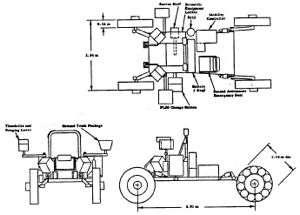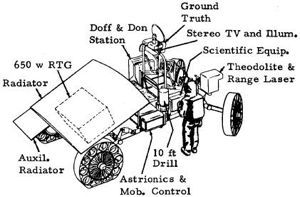
Home - Search - Browse - Alphabetic Index: 0- 1- 2- 3- 4- 5- 6- 7- 8- 9
A- B- C- D- E- F- G- H- I- J- K- L- M- N- O- P- Q- R- S- T- U- V- W- X- Y- Z
MOBEV RIB(1)E
 MOBEV RIB(1)E |
Status: Study 1966. Payload: 320 kg (700 lb). Gross mass: 1,272 kg (2,804 lb).
The vehicle would be landed aboard a LM-Shelter and was designed for a 90-day storage period after arrival on the lunar surface. Thermal control during this period was provided by the vehicle on-board RTG. The manned portion of the mission consisted of twelve 30-km sorties during a 14-day period. However, prior to and/or after this manned mode, the vehicle was capable of unmanned remote-controlled exploration. The six-month life of the 650-w RTG limited the time period during which these missions could be accomplished, but degraded versions could be undertaken after the six-month period. The vehicle carried 320 kg of scientific equipment with an average speed of 8 km/hr while manned. The unmanned average speed during the remote controlled mode was 2 km/hr.
The crew station accommodated the astronaut in a seated position. The seat was centered under the roll bar and access to the seat was from the front, using the folding steps. Controls and displays were integrated into the crew station structural assembly. The power subsystem consisted of a 650-w RTG, plus an AgCd battery. The battery provided for peak power demands above the RTG output, and was recharged by the RTG during periods of low power requirements.
In the unmanned mode the vehicle was capable of continuous operation; in the manned mode it could operate for six hours, and then required ten hours to recharge the battery. The mobility subsystem consisted of four individually driven and suspended metal-elastic wheels. The drive motors and transmissions were hub mounted. Steering was accomplished by actuators in the front wheels.
The astrionics subsystem consisted of communication, navigation, television, and illumination equipment. The communications equipment provided for remote control of the vehicle from earth, and communication between the vehicle and earth (S-band), the LM-Shelter (VHF), and another EVA astronaut (VHF). The navigation equipment provided a dead-reckoning capability with an accuracy of 1 km after traveling 50 km. The television equipment included a television camera providing a forward-looking stereo pair. The illumination equipment was provided as an aid in lunar night use of the vehicle.
RIBE Baseline Lunar Station Vehicle
- Delivered Mass (kg): 664
- Scientific Payload (kg): 320
- Crew Supplied Mass (kg): 58
- Total Operating Mass (kg): 864
- Number of Sorties/Range (km): 14/420
- Average Maximum Speed (km/hr): 8
- Obstacle (cm): 62
- Development Cost ($M): 35.1
- Development Time (Mos.): 33
R1B(1)E Greater Version Lunar Station Vehicle
- Delivered Mass (kg): 1071
- Scientific Payload (kg): 320
- Crew Supplied Mass (kg): 58
- Total Operating Mass (kg): 1272
- Number of Sorties/Range (km): 22/660
- Average Maximum Speed (km/hr): 8
- Obstacle (cm): 62
- Development Cost ($M): 82.5
- Development Time (Mos.): 36
Crew Size: 1. Crew: 58 kg (127 lb).
Family: Lunar Rovers, Moon. Country: USA. Agency: NASA, Bendix.
 | MOBEV RIB(1)E |
Back to top of page
Home - Search - Browse - Alphabetic Index: 0- 1- 2- 3- 4- 5- 6- 7- 8- 9
A- B- C- D- E- F- G- H- I- J- K- L- M- N- O- P- Q- R- S- T- U- V- W- X- Y- Z
© 1997-2019 Mark Wade - Contact
© / Conditions for Use